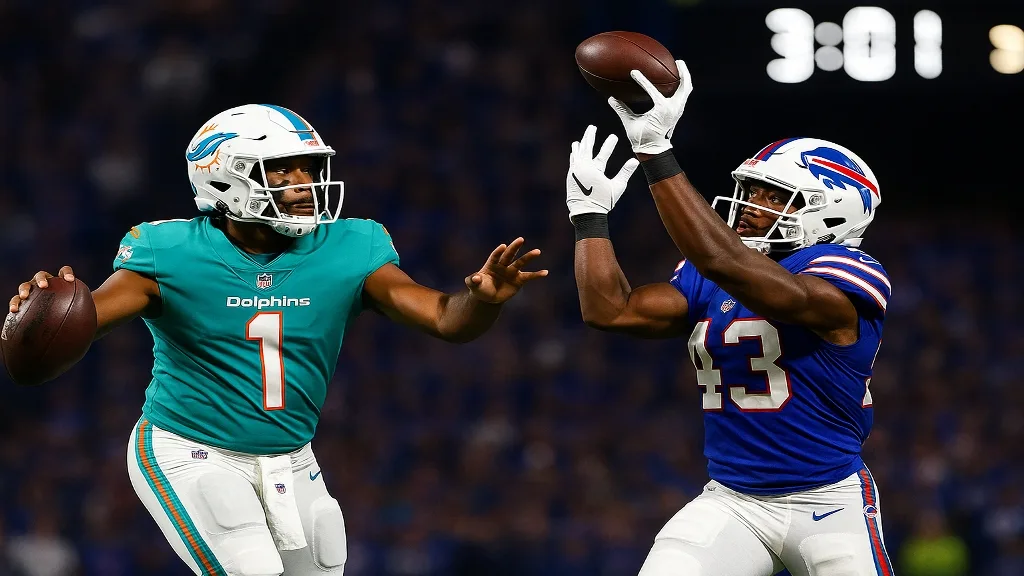The Miami Dolphins arrived in Orchard Park desperate to rewrite a lopsided script, only to see a late, tight contest slip away on a single, high-leverage mistake. With just over three minutes remaining and Miami driving inside the Buffalo 25, Tua Tagovailoa looked for a quick strike to Jaylen Waddle—and instead delivered the night’s turning point to linebacker Terrel Bernard.
The interception ignited Buffalo’s closing sequence and locked in a 31–21 Bills win, handing the Dolphins yet another defeat in a rivalry that’s grown increasingly one-sided on the road for Miami.
The Decisive Play: Read, Jump, Return, Dagger
On first-and-10 at the Bills’ 21, Tua Tagovailoa keyed on Waddle as pressure crowded the pocket. Bernard read the throw, jumped the route, and returned the pick 24 yards to flip the field and the final chapter. Buffalo methodically bled the clock, then Matt Prater’s kick with 27 seconds left put the game beyond reach, punctuating a fourth quarter that had seemed poised for another tie—until it wasn’t.
Tua Tagovailoa Line vs. The Narrative: Efficient Stretches, One Brutal Error
Tua Tagovailoa box score—22 of 34, 146 yards, two touchdowns, and that lone interception—tells a story of efficiency in rhythm drives undercut by the single turnover that mattered most. It was Miami’s only giveaway of the night, but it arrived in the red zone with the game on edge. Compounding the sting, the pick marked his third straight game with an interception, matching a career-worst streak and giving oxygen to early-season concerns about ball security.
Miami’s Fight Was Real: Fast Start, Timely Counters, Not Enough
For long stretches, Miami answered the moment. The Dolphins opened with a crisp touchdown drive to seize a 7–0 lead, then twice clawed back to even—first on a short Tua Tagovailoa dart to Waddle just before halftime, and again early in the fourth when Tyreek Hill knifed in for a five-yard score. When the offense stitched together three straight completions to extend the final march, it felt like a game destined for one more twist—until Bernard slammed the door.
What the Streak Says: Seven Straight to Buffalo, 0–3 in 2025
The loss extended Miami’s overall skid against Buffalo to seven in a row (including playoffs) and represented the Dolphins’ 10th consecutive road defeat in this matchup, a painful trend that persists even as Miami’s roster has evolved. The broader season context stings, too: at 0–3 for the first time since 2019—the year before Tua Tagovailoa arrival—the Dolphins now face both the standings and the psychology of an early hole.
Inside the Quotes: Accountability and Perspective from the Sideline
Head coach Mike McDaniel didn’t isolate blame, noting the difficulty of quarterback play under pressure while emphasizing team-wide responsibility. Tua Tagovailoa, for his part, credited Bernard for making a play, pointing to the timing and rhythm he saw pre-throw and acknowledging the coverage flashing into his lane as he tried to fit the ball. The shared theme: the margin was slim, the moment was decisive, and protection plus decision-making must be cleaner in money downs.
Anatomy of the Final Quarter: Small Edges, Huge Outcomes
Buffalo’s defense tightened its landmarks late, crowding Miami’s quick-game windows and forcing tighter reads. Miami’s offense, which had thrived when on-schedule, faced longer yardage after compressed first-down looks, making the red-zone read that much more precarious. One turnover plus a special-teams penalty at a critical juncture became the thin line between a statement road win and another Orchard Park lesson in details.
What Worked for Miami: Scripted Rhythm and Short-Area Punch
The opening-drive touchdown validated Miami’s script: tempo, defined reads, and ball-out timing let Tagovailoa string completions and keep Buffalo’s front from teeing off. In the green zone, leverage throws to Waddle and Hill showed the offense can still manufacture six when it gets to the low red. If the Dolphins can translate that sequencing into late-game consistency, the ceiling remains intact.
What Didn’t: Eye Discipline, Pressure, and Red-Zone Risk
The interception was a product of converging factors—pre-snap intent, post-snap pressure, and a linebacker reading Tua’s eyes. Buffalo disguised enough to muddy the flat defender and compress Tua Tagovailoa trigger point. In these spots, Miami must mix in a second read, a throwaway, or pocket movement that resets the picture; otherwise, good rhythm can be undone by one anticipatory defender.
Defensive Snapshot: Stops Without the Complement
Miami’s defense produced timely stands to manufacture the late chance, but complementary football wavered. Against Josh Allen and a methodical Bills group, the Dolphins needed either a takeaway or short-field stop to flip the script. Instead, Buffalo cashed the sudden-change opportunity born from Bernard’s return and nursed the clock with veteran precision.
Macro Trend: Turnovers as the Gatekeeper
For a precision-timed offense, a single giveaway is often the loudest variable. Through three weeks, Miami’s turnover profile has overshadowed stretches of crisp execution. Erasing the back-breaking mistake—especially inside the 25—will determine whether close losses become road statements against elite, division-rival defenses.
Coaching Lens: Process vs. Outcome
McDaniel’s postgame cadence underscored the balance between accountability and belief. Process metrics—early-down success, designed quick game, situational answers—were improved from the first two weeks. Outcome decided the night. The self-scout now turns to late-down spacing, eye control versus lurkers like Bernard, and pressure answers that allow Tua Tagovailoa to protect the ball without throttling aggression.
Player Lens: Tagovailoa’s Tightrope
Tua Tagovailoa game lives on anticipation, footwork, and trust. The same instincts that generate timing-window touchdowns can, under heat, invite risk if the post-snap picture shifts. The fix isn’t abandoning aggression; it’s sequencing: flash the primary, snap to the secondary, or manipulate with a shoulder before ripping the first look. That split-second discipline is the difference between “on-time” and “telegraphed.”
Rivalry Context: Orchard Park’s Edge
The Bills’ home edge has become psychological as well as tactical. Crowd noise condenses the clock. Buffalo’s second-level defenders—alert to Miami’s option routes and glance throws—sit on tendencies. Until the Dolphins flip one of these fourth-quarter scripts on the road, the rivalry will continue to feel uphill in the biggest moments.
What’s Next by Tua Tagovailoa: A Prime-Time Reset Opportunity
There’s no time to brood. Miami turns toward a Week 4 prime-time date with the Jets. Cleaning the turnover sheet—and cashing defensive stops with points—will define whether this 0–3 start is a blip or a trend. The tape offers both evidence of growth and a hard lesson in endgame execution. The antidote is simple and brutal: protect the ball, finish the drive.







